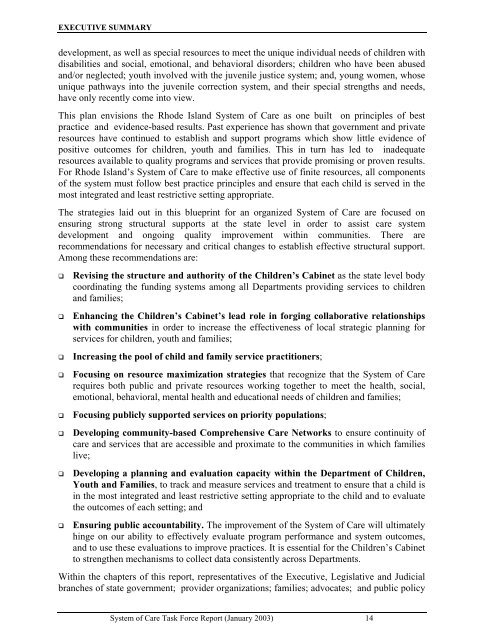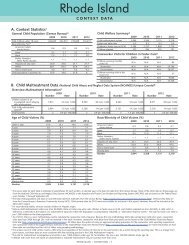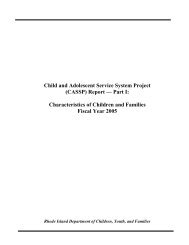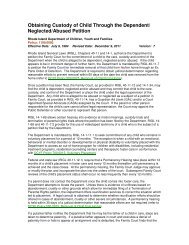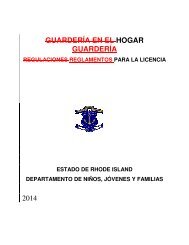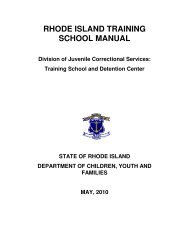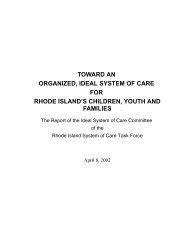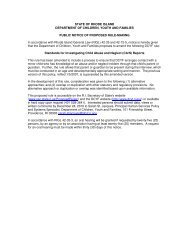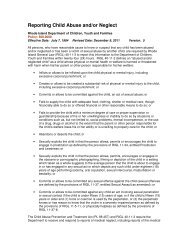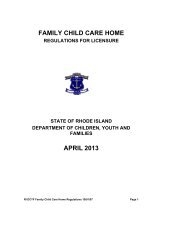Final Report - RI Department of Children, Youth & Families
Final Report - RI Department of Children, Youth & Families
Final Report - RI Department of Children, Youth & Families
Create successful ePaper yourself
Turn your PDF publications into a flip-book with our unique Google optimized e-Paper software.
EXECUTIVE SUMMARY<br />
development, as well as special resources to meet the unique individual needs <strong>of</strong> children with<br />
disabilities and social, emotional, and behavioral disorders; children who have been abused<br />
and/or neglected; youth involved with the juvenile justice system; and, young women, whose<br />
unique pathways into the juvenile correction system, and their special strengths and needs,<br />
have only recently come into view.<br />
This plan envisions the Rhode Island System <strong>of</strong> Care as one built on principles <strong>of</strong> best<br />
practice and evidence-based results. Past experience has shown that government and private<br />
resources have continued to establish and support programs which show little evidence <strong>of</strong><br />
positive outcomes for children, youth and families. This in turn has led to inadequate<br />
resources available to quality programs and services that provide promising or proven results.<br />
For Rhode Island’s System <strong>of</strong> Care to make effective use <strong>of</strong> finite resources, all components<br />
<strong>of</strong> the system must follow best practice principles and ensure that each child is served in the<br />
most integrated and least restrictive setting appropriate.<br />
The strategies laid out in this blueprint for an organized System <strong>of</strong> Care are focused on<br />
ensuring strong structural supports at the state level in order to assist care system<br />
development and ongoing quality improvement within communities. There are<br />
recommendations for necessary and critical changes to establish effective structural support.<br />
Among these recommendations are:<br />
! Revising the structure and authority <strong>of</strong> the <strong>Children</strong>’s Cabinet as the state level body<br />
coordinating the funding systems among all <strong>Department</strong>s providing services to children<br />
and families;<br />
! Enhancing the <strong>Children</strong>’s Cabinet’s lead role in forging collaborative relationships<br />
with communities in order to increase the effectiveness <strong>of</strong> local strategic planning for<br />
services for children, youth and families;<br />
! Increasing the pool <strong>of</strong> child and family service practitioners;<br />
! Focusing on resource maximization strategies that recognize that the System <strong>of</strong> Care<br />
requires both public and private resources working together to meet the health, social,<br />
emotional, behavioral, mental health and educational needs <strong>of</strong> children and families;<br />
! Focusing publicly supported services on priority populations;<br />
! Developing community-based Comprehensive Care Networks to ensure continuity <strong>of</strong><br />
care and services that are accessible and proximate to the communities in which families<br />
live;<br />
! Developing a planning and evaluation capacity within the <strong>Department</strong> <strong>of</strong> <strong>Children</strong>,<br />
<strong>Youth</strong> and <strong>Families</strong>, to track and measure services and treatment to ensure that a child is<br />
in the most integrated and least restrictive setting appropriate to the child and to evaluate<br />
the outcomes <strong>of</strong> each setting; and<br />
! Ensuring public accountability. The improvement <strong>of</strong> the System <strong>of</strong> Care will ultimately<br />
hinge on our ability to effectively evaluate program performance and system outcomes,<br />
and to use these evaluations to improve practices. It is essential for the <strong>Children</strong>’s Cabinet<br />
to strengthen mechanisms to collect data consistently across <strong>Department</strong>s.<br />
Within the chapters <strong>of</strong> this report, representatives <strong>of</strong> the Executive, Legislative and Judicial<br />
branches <strong>of</strong> state government; provider organizations; families; advocates; and public policy<br />
System <strong>of</strong> Care Task Force <strong>Report</strong> (January 2003) 14


